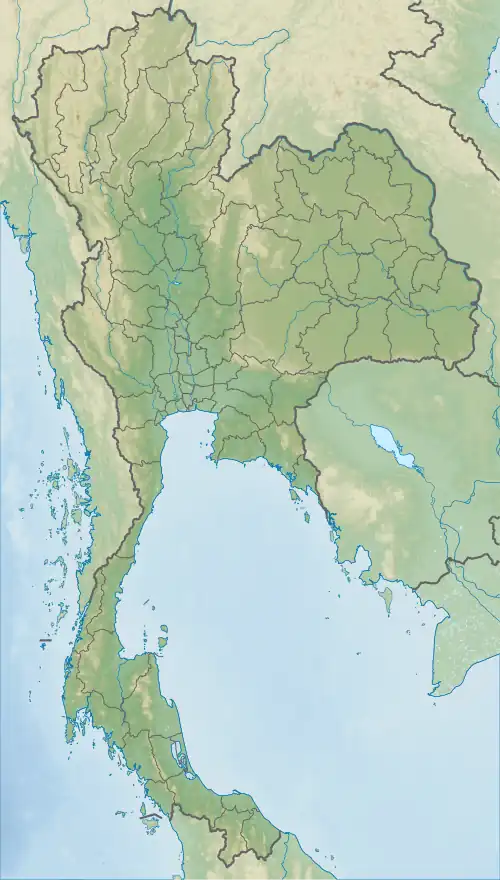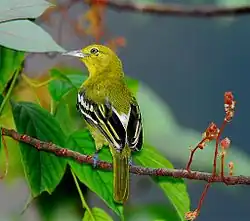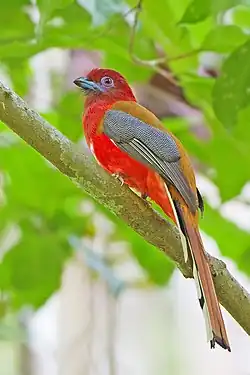Khao Laem National Park
| Khao Laem National Park | |
|---|---|
Khao Laem Sea of Mist | |
 Map of Thailand | |
| Location | Kanchanaburi province, Thailand |
| Nearest city | Sangkhlaburi |
| Coordinates | 15°01′20″N 98°35′50″E / 15.02222°N 98.59722°E |
| Area | 1,497 km2 (578 sq mi)[1] |
| Established | 5 December 1991 [2] |
| Visitors | 48,599 (in 2024)[3] |
| Governing body | Department of National Parks, Wildlife and Plant Conservation |
Khao Laem National Park is a park of about 1,500 squaere kilometer (580 sq mi) in Western Thailand, located near Myanmar in the northern area of the Tenasserim Hills, Kanchanaburi Province. It is a part of the Western Forest Complex, a system of protected wilderness in the Dawna-Tenasserim Hills area of western Thailand.
The park hosted the second season of New Zealand version of Survivor, Survivor NZ: Thailand.[4]
Geography
The area of the park is 935,584 rai ~ 1,497 square kilometres (578 sq mi)[1] with steeply limestone mountain run on north–south axis. The park, which is adjacent to the Thungyai Naresuan Wildlife Sanctuary, Lam Khlong Ngu National Park and Thong Pha Phum National Park, located about 340 km northwest of Bangkok, surrounds the Khao Laem Reservoir wih a water surface of 388 square kilometres (150 sq mi), or 26% of the park. It is bisected by Road 323.
The limestone mountains of the Tenasserim Range rise from 100 to 1,800 meters high with Khao Khiao-Khao Yai as the highest summit at 1,767 meters (5,800 ft).
Many streams flowing into Khwae Noi River and Vajiralongkorn Reservoir.[5]
History
The establishment of the national park was declared the 67th national park in the Royal Gazette on 8 November 1991 and came into effect 5 December the same year. This park area was further modified in the years 2002 and 2009.[2]
Climate
The area is in a tropical climate, influenced by monsoons, southeasterly winds and the Andaman Sea breezes. The region's annual weather patterns are divided into three main seasonal periods:[6]
- Rainy season (mid-May to October): the heaviest rainfall in July and August.
- Cold season (November to February): the lowest average temperature is 14 °C (57 °F).
- Summer (March to mid-May): the maximun average temperature is 38 °C (100 °F), in April.
Flora
The vegetation in the east and west of the park is mixed deciduous forest:[7]
Fauna
Mammals

The number of sigthing in the park are ten species of mammals, include:[8]
Birds
The park has some 249 species of birds from 67 families.
Passerine
145 species of passerine from 37 families, represented by one species:[9]

- Ashy woodswallow
- Asian fairy-bluebird
- Black-naped monarch
- Black-naped oriole
- Blue pitta
- Chestnut-flanked white-eye
- Common green-magpie
- Common hill myna
- Common iora
- Common rosefinch
- Eastern red-rumped swallow
- Eurasian tree sparrow
- Eyebrowed thrush
- Gray-headed canary-flycatcher
- Gray wagtail
- Greater green leafbird
- Indochinese cuckooshrike
- Lesser necklaced laughingthrush
- Long-tailed broadbill
- Malaysian pied-fantail
- Maroon-breasted philentoma
- Olive bulbul
- Oriental magpie-robin
- Ornate sunbird
- Puff-throated babbler
- Rufescent prinia
- Scaly-breasted munia
- Scarlet-backed flowerpecker
- Short-tailed drongo
- Spot-necked babbler
- Sultan tit
- Thick-billed warbler
- Tiger shrike
- Velvet-fronted nuthatch
- White-bellied erpornis
- Yellow-bellied warbler
- Yellow-browed warbler
Non-passerine

(Harpactes erythrocephalus)
107 species of non-passerine from 30 families, represented by one species:[10]
- Asian openbill
- Black-winged stilt
- Chestnut-headed bee-eater
- Chinese pond-heron
- Common sandpiper
- Crested treeswift
- Eastern barn owl
- Eurasian hoopoe
- Great eared-nightjar
- Greater coucal
- Great hornbill
- Himalayan swiftlet
- Indochinese roller
- Japanese sparrowhawk
- Lesser whistling-duck
- Lineated barbet
- Little cormorant
- Little grebe
- mountain scops-owl
- Orange-breasted green-pigeon
- Oriental darter
- Osprey
- Peregrine falcon
- Red-headed trogon
- Red junglefowl
- Red-wattled lapwing
- Rufous woodpecker
- Stork-billed kingfisher
- Vernal hanging-parrot
- White-breasted waterhen
Reptiles
The number of sightings in the park are eight species of reptiles, include:[11]
Amphibians
The number of sightings in the park are ten species of amphibians, include:[12]
Fishes
The number of sughtings in the park are thirteen species of fishes, include:[13]
Attractions
| * Namtok Kra Teng Jeng | a waterfall with 23 levels over 2 km.[14] |
| * Namtok Kroeng Kra Wai | a 5 meter high waterfall. |
| * Namtok Pha Tak | a 5 tiered waterfall. |
Location
| Khao Laem National Park in overview PARO 3 (Ban Pong) | |||||||||||||||||||||||||||||||||||||||||||||||||||||||||
_EN.svg.png)
|
See also
- IUCN protected area categories
- Map of Khao Laem National Park
- Western Forest Complex
- List of national parks of Thailand
- PARO 3 (Ban Pong)
References
- ^ a b
"ข้อมูลพื้นที่อุทยานแห่งชาติที่ประกาศในราชกิจจานุเบกษา 133 แห่ง" [Area Information of 133 National Parks published in the Government Gazette] (in Thai). Department of National Parks, Wildlife and Plant Conservation. December 2022. Retrieved 21 June 2024, No.67 Khao Laem N.P., Area = 935,584 rai ~ 1,497 sqkm
{{cite web}}: CS1 maint: postscript (link) - ^ a b "Khao Laem National Park > Background". Department National Parks, Wildlife and Plant Conservation (DNP). Retrieved 19 August 2025.
- ^
"สถิตินักท่องเที่ยวที่เข้าไปในอุทยานแห่งชาติ ปีงบบ่ระมาณ พ.ศ. 2567" [Statistics of tourists visiting national parks in fiscal year 2024]. Department National Parks, Wildlife and Plant Conservation (DNP) (in Thai). Retrieved 14 August 2025, PARO 3 - no.18 Khao Laem N.P. 48,599
{{cite web}}: CS1 maint: postscript (link) - ^ Fenwick, George (22 April 2018). "Thailand: braving the roads to Sangkhlaburi, ahead of Survivor New Zealand series two". The New Zealand Herald. Retrieved 7 January 2020.
- ^ "Khao Laem National Park > Landform". Department National Parks, Wildlife and Plant Conservation (DNP). Retrieved 19 August 2025.
- ^ "Khao Laem National Park > Weather". Department National Parks, Wildlife and Plant Conservation (DNP). Retrieved 19 August 2025.
- ^ "Khao Laem National Park > Plants". Department National Parks, Wildlife and Plant Conservation (DNP). Retrieved 19 August 2025.
- ^ "Khao Laem National Park > Mammals". Department National Parks, Wildlife and Plant Conservation (DNP). Retrieved 19 August 2025.
- ^ "Khao Laem National Park > Passeriformes". Avibase - The World Bird Database. Retrieved 19 August 2025.
- ^ "Khao Laem National Park > Non-passeriformes". Avibase - The World Bird Database. Retrieved 19 August 2025.
- ^ "Khao Laem National Park > Reptiles". Department National Parks, Wildlife and Plant Conservation (DNP). Retrieved 19 August 2025.
- ^ "Khao Laem National Park > Amphibians". Department National Parks, Wildlife and Plant Conservation (DNP). Retrieved 19 August 2025.
- ^ "Khao Laem National Park > Fishes". Department National Parks, Wildlife and Plant Conservation (DNP). Retrieved 19 August 2025.
- ^ "Protected areas > Khao Laem National Park". Foundation Western Forest Complex Conservation (FWFCC). Retrieved 19 August 2025.